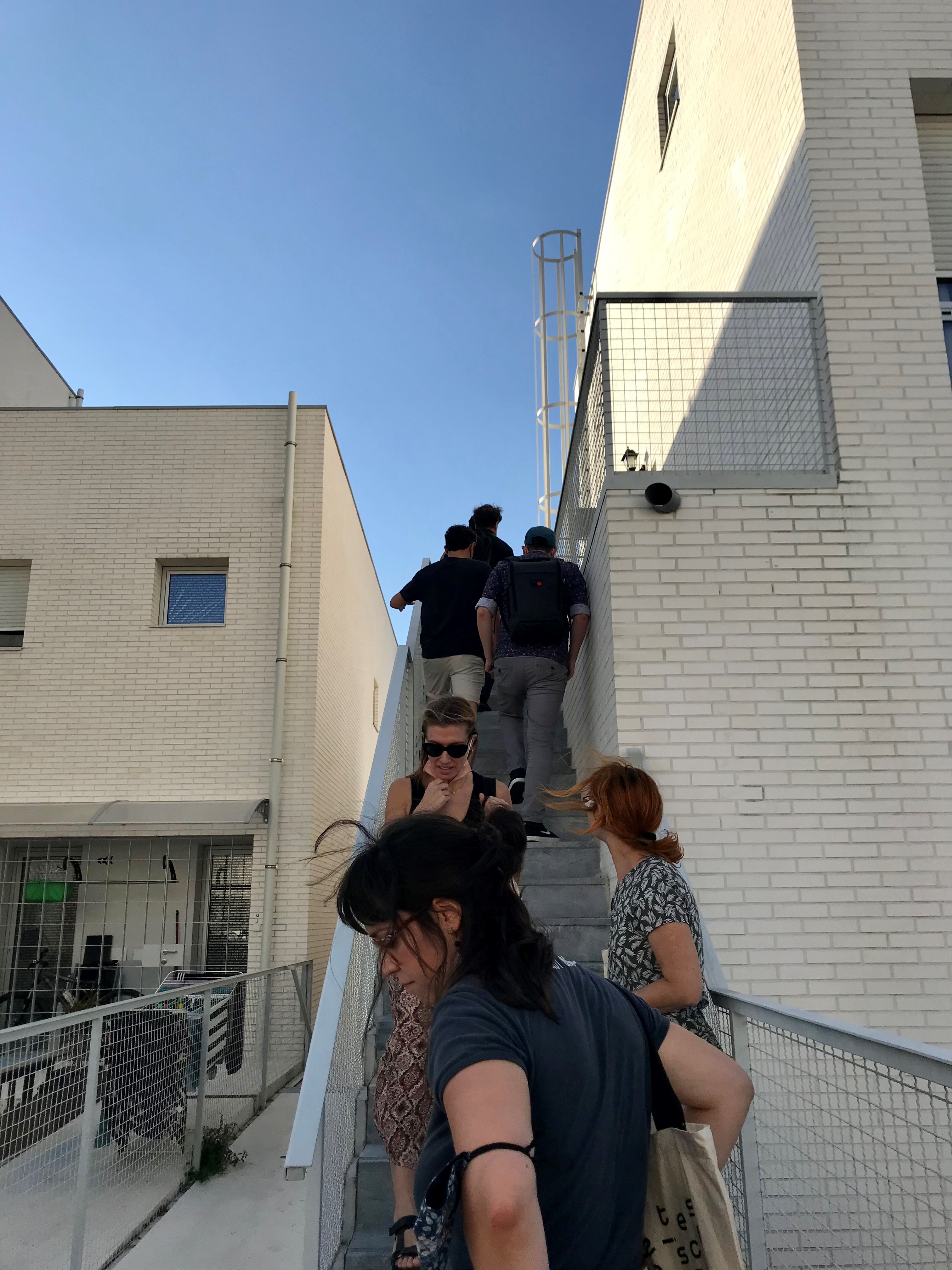Links between sustainability and BIM
Posted on 10-12-2021
The Lisbon workshop not only facilitated training activities, but it was also the first opportunity to finally meet the fellow Early-Stage Researchers in person after 3 months of online encounters. During the 3-day workshop we were able to have fruitful conversations and some lively debates ranging from the use of the term ‘vulnerable people’, to how to ethically carry out community-led projects in practice, to intersectionality. Activities included a roundtable discussion, lectures, and site visits to the Boavista eco-neighbourhood and self-build housing in Marvila to name a few. These provided different lenses with which to view a holistic sustainable approach such as more intangible social aspects, as well as ways to digitally support and represent this information.
Discussions about BIM
Building Information Modelling (BIM) is a methodology that focuses on emerging technology to parametrically model and operate building information within a digital platform (Love et al., 2013). BIM will play a crucial role in the future of housing to be able to measure and meet sustainability targets through improved energy and resource efficiency throughout the entire lifespan of a building. We had two lectures which focused on BIM, one given by Miguel Pires from construction company Grupo Casais and another by Miguel Azenha from Minho University in Portugal. Grupo Casais’ lecture gave valuable insights into how BIM software is currently being used within industry. Miguel Azenha’s lecture provided a methodological perspective covering standardisation and circularity, according to whom standardisation is affecting BIM and influencing the way people in construction are using information. In addition, circular economy principles are implicit to the concept of BIM and support the feasibility for Design for Deconstruction (DfD). Interestingly, BIM was also described as object-oriented modelling, in which even voids are modelled as objects. This lead me question how can ‘intangible’ social sustainability factors (such as health and wellbeing of residents) also be represented in a BIM environment which is object oriented?
Social sustainability and impact on communities
As mentioned, the workshop included visits to neighbourhoods in Lisbon that had incorporated sustainability and affordability into their design, including a visit to Boavista (a new sustainable neighbourhood providing rented social housing) led by architect Miguel Brito from Lisbon municipality [1]. The homes in the completed and inhabited pilot neighbourhood were based on a modular design - though built using traditional construction techniques. Within the project, there was a focus on improving energy efficiency to reduce fuel bills, whilst upgrading and rehousing an existing community previously located only one road away. During the trip we were invited inside the homes on a small tour where we were able to talk with residents and find out what life is like in the new neighbourhood. Importantly, this pilot project provides the opportunity to address any design issues for the roll-out of the planned future neighbourhoods in Lisbon that will be based on the same design.
Another project which centred on dialogues with residents to foster community participation was informal settlement Terras da Costa (located 10km from Lisbon) presented by architect and urban researcher Joana Pestana Lages (Pestana Lages and Gouveia Braga, 2016). The informal settlement is home to a Cape-Verdean community that has lived in the area for decades. The municipality planned to rehouse the residents in a resettlement project, the social implications of which were discussed by Lages. The new housing solution had the potential to socially isolate residents as well having a negative economic impact, as some residents relied on the land to keep livestock as part of their livelihood. Conventional European housing therefore posed the potential to radically change the lives of the residents that would move into them. The numerous issues raised by Lages in the case of informal settlements and the human right for all to live and thrive in our cities (Harvey, 2003) is relevant across Europe. There are informal settlements in several member states currently under transformation in line with the UN Sustainable Development Goals, including Cuñada Real in Madrid which is Europe’s largest informal settlement.
How to link social sustainability and BIM?
Coming away from the workshop, I have been keen to ensure my own research project provides holistic solutions to sustainable and affordable housing in combination with ICTs such as BIM. The importance and challenges of incorporating social aspects of sustainability is represented by a growing body of research in Social Life Cycle Analysis (SLCA). This can be understood as a component of the “Triple Bottom Line” (TBL) model of sustainability which integrates environmental, economic, and social indicators. This can be achieved through using the corresponding methodologies of Life Cycle Analysis (LCA) (environmental), Life Cycle Costing Analysis (LCCA) (economic), together with Social Life Cycle Analysis (SLCA) (social). BIM plays a key role in measuring and unifying these holistic indicators. This is important to document during the typical 50 to 60 years of a building’s lifespan to ensure that not only environmental targets are met, but to ensure a high quality of life for inhabitants. This information becomes even more crucial at the ‘beyond building life stage’ when housing is ultimately deconstructed and reused - long after the working lifetime of the original design team. These themes are currently being explored during the forming of my individual research project, in which I am investigating Industrialised Construction in connection with BIM and sustainability.
References
Harvey, D. (2003) ‘The Right to the City’, International Journal of Urban and Regional Research, 27, pp. 939–941. doi: 10.1111/j.0309-1317.2003.00492.x.
Love, P. E. D. et al. (2013) ‘From justification to evaluation: Building information modeling for asset owners’, Automation in Construction, 35, pp. 208–216. doi: 10.1016/j.autcon.2013.05.008.
Pestana Lages, J. and Gouveia Braga, J. (2016) ‘There is Africa in Lisbon’, in Embodying difference in the discourse and practices of urban planning. Zurich, pp. 1–11. Available at: https://ethz.ch/content/dam/ethz/special-interest/conference-websites-dam/no-cost-housing-dam/documents/Lages_Paper.pdf.
Bibliography
Further reading on BIM and object-oriented modelling:
Van Nederveen, S., Beheshti, R. and Gielingh, W. (2010) ‘Modelling Concepts for BIM’, in Underwood, J. and Isikdag, U. (eds) Handbook of research on building information modelling and construction informatics: concepts and technologies. IGI Global Publishing, pp. 1–18. doi: 10.4018/978-1-60566-928-1.ch001.



